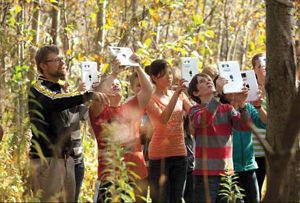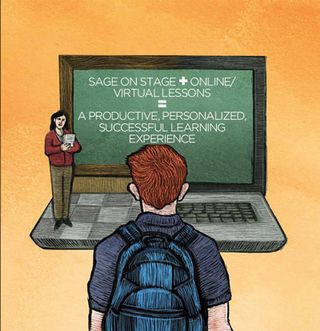Regardless of how it’s implemented, let’s define blended learning as a combination of offline and online learning. Although each district envisions and handles it differently, we can all agree that it’s a great way—short of hiring an additional 10 teachers per class—to let teachers differentiate instruction. To help get some insight, we asked a few districts to share their expertise: how they revamped their curricula, how they got their teachers on board, and how they’re handling assessments. Here are their stories.
STEP 1:
Co-opting Curriculum
When a tornado devastated Joplin, Missouri, in the spring of 2011, the Joplin School System took the opportunity to reinvent itself. “We invited everyone in—the Board, our teachers, the community—and asked for their input on curriculum development,” says Traci D. House, director of technology. The teachers wanted to use Blackboard as their learning management system (LMS). They told House that to adopt a one-to-one, textbook-free, blended learning environment, they needed flexibility, leniency, and the creative license to learn with their students. They wanted student input for help with transforming the framework, and they wanted collaboration. “As a result, our Google Apps usage went through the roof!” says House.
Although some teachers use Moodle, most of the district uses Blackboard, and House says more teachers are migrating to Blackboard all the time. The district likes the Blackboard add-ons, which House says are easy to use and relatively inexpensive. Two favorites are Turnitin, to check for plagiarism, and NBC Learn, to create assignments. Also, Blackboard links up with the student management system.
The first year was a learning experience for everyone, admits House. When the communication arts teacher wanted to have paper versions of classic novels, for instance, House said, “We have Adobe Pro on every laptop. If you open the books in Adobe Pro instead of downloading as a PDF, you can highlight, take notes, and so on.” That experience led her to realize that she needed to provide more tech options for teachers.
Marshall School students photograph fall leaves for a science lesson on classification.At the Marshall School, a 4th through 12th grade private school in Duluth, Minnesota, a partnership led to offering blended opportunities. “We took curriculum from the VHS Collaborative and are using it in a face-to-face (F2F) setting,” says Michael Ehrhardt, head of the Marshall School. Ehrhardt’s staff learned that the structure of an online course, which is broken down into weekly skills development and expectations, made a nice launching point for blended courses. “From that base point, you have to figure out what types of meaningful activities you need to do together and what you can leave in an online digital format for students to do at their own pace,” says Ehrhardt. “You have to ask yourself: What lectures can inspire students? When is hearing someone F2F more meaningful?”

For Aaron Turpin, executive director of technology at Hall County School District in Georgia, blended learning is tied to learning styles and passions. For about eight years, Hall County teachers have used the Renzulli Profiler to individualize instruction. In a class that’s studying volcanoes, for instance, some children work in groups, others by themselves, some of them online, and others in a teacher-directed setting. Students work at home, in the learning commons, or anywhere they can connect to the Internet. In fact, the district is moving toward partial enrollment. “Within a year we’ll have kids coming to school different amounts of days,” says Turpin.
Since April, language arts and math teachers have created assessments and built units with digital assets suggested by Turpin’s team. Twothirds of those assets are free Web 2.0 tools, such as the ones for teaching about volcanoes from the University of Colorado. “There is great stuff out there!” says Turpin. “Over the past couple of years we’ve collected 20,000 digital assets and tagged them to standards. We teach a unit as a district and teachers toss additional assets they’ve discovered into an online drop box. When a unit is done, master teachers cull the additional assets so we will end up with district units in a blendedlearning format that will lead to a course. From those, a teacher can individualize for students.”
The district uses Hall Connect, a Dell Learning Platform, to integrate applications and resources and deliver personalized learning resources. Within Hall Connect is Safari Montage, which comes with its own resources, as well as the additional digital assets the district has gathered from such sources as Rice University and CK-12 Foundation. Hall Connect allows teachers to identify resources based on learning styles and to collaborate. “They can do whole-class or small-group collaboration, and teachers can participate in PLCs,” says Turpin.
STEP 2:
Training the Troops
It’s all about coaching at Joplin Schools. There are nine coaches that cover elementary and middle schools, plus another five whose sole focus is high school. “Initially, the coaches were ‘beat up’ by the reluctant teachers, but a lot of the naysayers have become the biggest advocates,” says House. Her biggest lesson so far? “You have to compromise. Initially we said, ‘No more classroommanagement software on the computers. If you’re walking around you should see what’s happening.’ But we found that even the really good teachers who walked around said it was hard to maintain control, so we came up with a little software piece that lets them restrict links as necessary.”
A number of Marshall School teachers took classes in VHS’s five-part PD series to help them learn how to incorporate different elements into their instruction. The classes, led by VHS instructors, start with using online tools and lead up to creating a blended class. Teachers can take the classes even if they aren’t VHS members.
A small group of 4th graders at World Language Academy in Hall County, Georgia, works asynchronously on science standards.For Turpin, the answer was delivering PD in a blended-learning context. The first summer, 100 teachers did a two-week training focused on how to approach blended learning. “We learned that the two-week timeframe was too compact to allow them to absorb everything,” says Turpin. Since then, he upped the training to six months, starting with 44 Title 1 teachers who learned via flipped classroom techniques, online classes, and F2F. Some of the teachers formed PLCs, and the blended classes had more improvement than their non-blended counterparts, with the greatest gains made by special-ed students. Today, now that 2,000 teachers have been trained, he is using PD money for year-long trainings with departments or in subject areas.

Step 3:
Aligning Assessment
Kecia Ray, executive director of learning technology for Metropolitan Nashville Public Schools (MNPS), looks for applications that have assessment built in. “With any software vendor, we must be able to export the data from their system and import it into ours so we can make sure we have what we need to make the right decisions for our students.” Any school writing a software grant brainstorms with Ray’s department to pick the best products.
Recently, when she met with a school that is starting a blended model, they identified grade levels and decided to try virtual looping. The teachers will develop collaborative lessons using SMART Notebook that cover two grades, and students will have access to either grade-level lesson. “So a third grader can use second-grade reading material and there’s no embarrassment, or she might get third-grade math lessons for one topic and second-grade for the next, depending on her skills,” says Ray. “The faculty is really excited. We will have a year’s worth of virtual lessons for both grades.”
At Hall County, assessments are also built in. “We begin with assessment and it’s never A,B,C,D,” says Turpin. “It’s always a product-based assessment. We want students to manipulate knowledge they have acquired to create new knowledge.”
His teachers build assessments before creating the units. As mentioned above, the units are filled with various digital assets that address different learning styles and passions, so teachers can select the right assignment for each student.
“We had to create a sense of urgency. Our students won’t be competing against kids from Atlanta, Austin, and Iowa—they’ll be competing against kids from Taiwan, Siberia, and so on. If they are going to be competitive they must be taught in ways that allow them to think critically and manipulate knowledge into whatever problem is at hand. That can’t happen with someone standing in front of the class.”
Back Office Business
A low-performing D.C. middle school implements blended learning
Challenge: Kramer Middle School wanted to supplement its classroom learning by creating a blended school that combines personalized online classes with face-to-face time.

Solution: The school partnered with Atomic Learning; all elements of the program—including the online instruction—take place in the classrooms. “With this blended school model, the Kramer staff of strong, dedicated teachers works with students to make the most of every minute of the school day,” says Kramer Middle School principal Kwame Simmons.
Kearney Public Schools goes on a [blended] learning Odyssey
Challenge: The leaders at Kearney Public Schools, in Nebraska, wanted to create personalized learning opportunities for every student.

Solution: By introducing CompassLearning Odyssey into the curriculum, the district can use student data to offer rigorous lessons and activities based on each student’s ability within a particular subject. The Odyssey curriculum is online and includes regular assessments. “By using data, digital content, and creating personalized learning paths, CompassLearning helps us meet each student where they are,” says Dick Meyer, director of curriculum, instruction, and assessment.
A Kansas City school wanted stronger, data-driven professional development
Challenge: The principal at a school in Kansas City wanted to offer data-driven professional development to his faculty and staff.

Solution: “Observe4success has helped us stay current with the research in this field and has played a big part in helping Genesis Promise Academy identify areas that will benefit from additional professional development,” says Philip Hickman, principal and director of education. “Observe4success tracks the date, time, duration, and observer every time we are in the classroom. It’s been helpful to show exactly when and with what kind of frequency we are getting into each of the classrooms.”
A Texas district selects the right provider to deliver online classes
Challenge: The Galveston Independent School District in Texas needed high-capacity Internet connectivity to support the district’s surging bandwidth needs, particularly for delivering virtual classes and online testing.

Solution: To get a fast, reliable Internet connection, the district chose Comcast Business Class Ethernet. One of the tech-based programs Comcast will help with is the Galveston Island Virtual E-Schools, which lets students take courses online. “Both in daily operations and in the event of a natural disaster, a reliable connection acts as our central hub for communicating with students, parents, and staff alike so that we do not fall behind,” says John Mathis, the MIS director for the district.
Stronger professional development is the goal for this South Dakota district
Challenge: Beresford School District in South Dakota needed to improve teaching quality by providing consistency and individualized training throughout the district.

Solution: Pearson’s Teacher Compass, an online program that lets administrators collect teacher observation data and tie it to on-demand professional development, is what the district selected.

